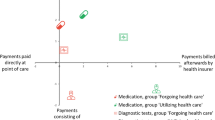Abstract
Previous studies of preferences for health insurance benefits have required individuals to make a series of complex and repetitive decisions, and have assumed that all insured benefits are desirable. This study reports the development and testing of a simple, innovative instrument to measure preferences for health insurance benefits. The newly developed instrument (Puzzle) is designed to allow subjects to select health benefits in a way that underscores the trade-offs dictated by budgets and costs. A “puzzle-like” frame representing budget constraints and “puzzle piece” benefit cards proportionately sized to represent the premium price of a single year's coverage comprise the instrument. In a comparison procedure (Money Game), participants “purchase” individual benefits by exchanging “play” money for benefit tokens. The Puzzle's utility was assessed by examining the convergence of results from both instruments and the subject's ratings of and preference for the instruments. One hundred five elderly Medicare enrollees seen in the general Internal Medicine outpatient clinic of a major southeastern teaching hospital were interviewed. Subjects answered interviewer-administered questionnaires and completed both the Puzzle and the Money Game. Both McNemar's test and Kendall's tau-b indicated a high degree of concordance between benefit choices made using the two instruments. Descriptive statistics demonstrated that the Puzzle was clear, easy to use, understandable, and preferred to the Money Game. The results suggest that the Puzzle is a promising tool for assessing health insurance coverage preferences under circumstances of limited expenditures, which can be modified for use with various populations who face limited insurance benefits.
Similar content being viewed by others
References
Berki SE, Ashcraft ML. HMO enrollment: Who joins what and why: A review of the literature. Milbank Mem Fund Q 1980; 4:588-632.
Mechanic D, Ettel T, Davis D. Choosing among health insurance options: A study of new employees. Inquiry 1990; 27:14-23.
Grazier KL, Richardson WC, Martin DP, Diehr P. Factors affecting choice of health care plans. Health Serv Res 1986; 20:659-682.
Sofaer S, Kenney E, Davidson B. The effect of the illness episode approach on Medicare beneficiaries' health insurance decisions. Health Serv Res 1992; 27:671-693.
Fowler FJ, Berwick DM, Roman A, Massagli MP. Measuring public priorities for insurable health care. Med Care 1994; 32:625-639.
Pfeiffer E. A short portable mental status questionnaire for the assessment of organic brain deficit in elderly patients. J Am Geriatr Soc 1975; 23:433-441.
Health Care Financing Administration. Medicare and Medicaid statistical supplement, 1995. Health Care Financ Rev 1995:28.
Danis M, Biddle AK, Henderson G, Garrett JM, DeVellis RF. Elderly Medicare enrollees' choices for insured services. J Am Geriatr Soc 1997; 45:688-694.
Mantel N, Haenszel W. Statistical aspects of the analysis of data from retrospective studies of disease. J Am Stat Assoc 1959; 58:690-700.
McNemar Q. Note on how the sampling error of the difference between correlated proportions or percentages. Psychometrika 1947; 12:153-157.
Daniel WW. Applied Nonparametric Statistics. Boston: Houghton-Mifflin, Co., 1978, pp 146-150, 306-315.
Nunnally JC, Bernstein IH. Psychometric Theory. 3rd ed. New York: McGraw-Hill, 1994, pp 130-131.
Havighurst CC. Prospective self-denial: Can consumers contract today to accept health care rationing tomorrow? University of Pennsylvania Law Review 1992; 140:1755-1808.
Rights and permissions
About this article
Cite this article
Biddle, A.K., DeVellis, R.F., Henderson, G. et al. The Health Insurance Puzzle: A New Approach to Assessing Patient Coverage Preferences. Journal of Community Health 23, 181–194 (1998). https://doi.org/10.1023/A:1018716414735
Issue Date:
DOI: https://doi.org/10.1023/A:1018716414735




